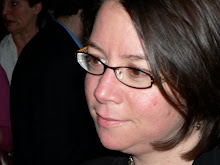When I picked Jordan up from school today, he snuck up behind me and honked, using a fun little reed instrument he made out of a drinking straw. It was for a science lesson. You cut the end of the straw into a point, flatten it by biting it a little, and blow into it with a little buzz in your blow, the way you do for a kazoo but less vocally. It makes a great sound! Jordan loved it. He had two different straws of slightly different diameter, and by fitting one into the other, he had made a thing like a slide whistle or trombone, where you slide the pitch by making the instrument physically longer and shorter. He played it all the way home. Between tunes, he chatted me up about sound and vibrations.
Jordan: Mommy I learned that sound is waves. It's the vibration.
Me: Can you explain to me how this thing works?
Jordan: The air makes the straw vibrate and that makes the sound.
Me: Huh. I have not thought about this before and you are really making me think. Does the air make the straw vibrate, or does the straw make the air vibrate?
Jordan: The air makes the straw vibrate. Because you have to blow. And you have to blow in a certain way to make the straw go buzz, and that is the sound.
Me: Wow. I think that is totally right. You even have to blow in a certain way, a kind of a buzzy blow, or it won't work. So it's sort of like, you make the air go buzz, and the air makes the straw go buzz?
Jordan: That's what I think. I'm just guessing about this right now.
Me: That's okay, that's called figuring it out. We use what we know to figure out new things. I'm figuring it out too. What I don't understand yet is how the sound gets to my ears. Because I think the sound has to get to my ears for me to hear it.
Jordan: I think the sound is the waves, and the sound cuts through the air to get to your ear faster. The sound is the waves, and the air is like the sand on the beach. Have you seen how the waves at the beach can kind of cut through the sand? Like that.
Me: Far out. That's different than how I think of it. I think the sound is the air that is vibrating.
Jordan: I never thought of it that way. That's a new idea to me.
Since we were on our way to Jordan's choir practice, I asked:
Me: Do you think this has anything to do with singing?
Jordan: No. I think it is completely different.
Me: How do you think singing works?
Jordan: I think the air goes over that little thing that hangs down in the back of your mouth and vibrates it and that makes the sound.
Me: That's called the uvula. I have no idea what that thing is for. But the way you are describing it, it sounds a lot like what you said happens with the straw.
Jordan: Uvula?!?! [He thought the sound of the word was hilarious and practiced saying it over and over.]
Me: Yeah. I don't know what it's for. I think that singing sounds come from a thing that is farther down your throat called the larynx.
Jordan: Is that the voice box?
Me: Right, that.
Jordan: I think that has little strings in it and those vibrate to make the sound. And there has to be the air to make it vibrate because you breathe when you sing.
As we arrived at choir, I said maybe his choir director would know about how sound is made for singing, and he decided he wanted to talk about it at the break and maybe show how his instrument works.
I have since learned that the uvula does play a bit of a role in the articulation of some sounds, but mostly just glottal stops, not notes. I wonder Jordan got his idea about the uvula from cartoon images of people yelling. The "strings" in the larynx may have been a reference to the "vocal cords," which apparently are not so much cords as folds in the tissue. Which makes the larynx more like a reed instrument, right?
Thursday, January 24, 2013
Subscribe to:
Post Comments (Atom)


1 comment:
"If I were not a physicist, I would probably be a musician. I often think in music. I live my daydreams in music. I see my life in terms of music. ... I get most joy in life out of music." -- Albert Einstein
Post a Comment